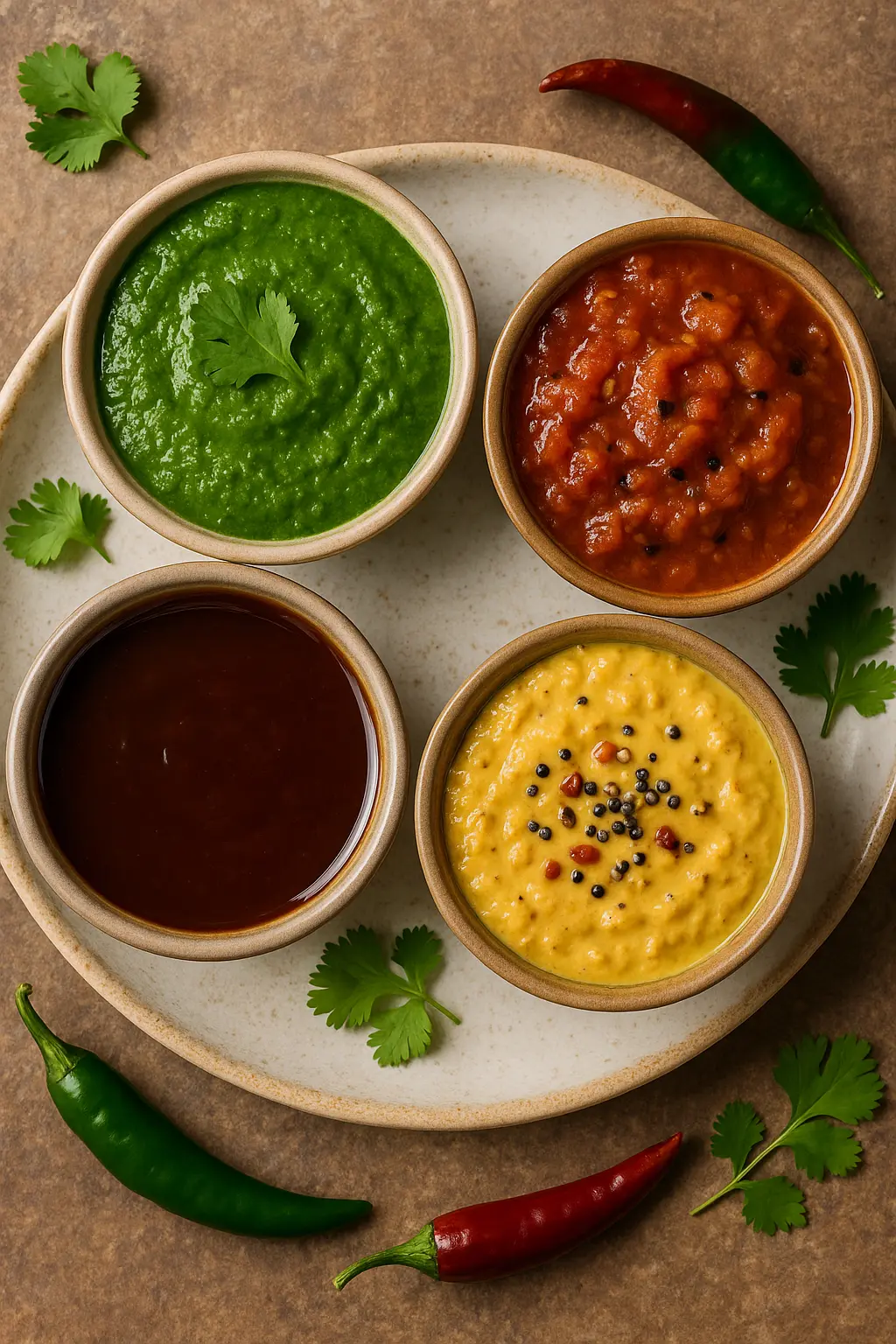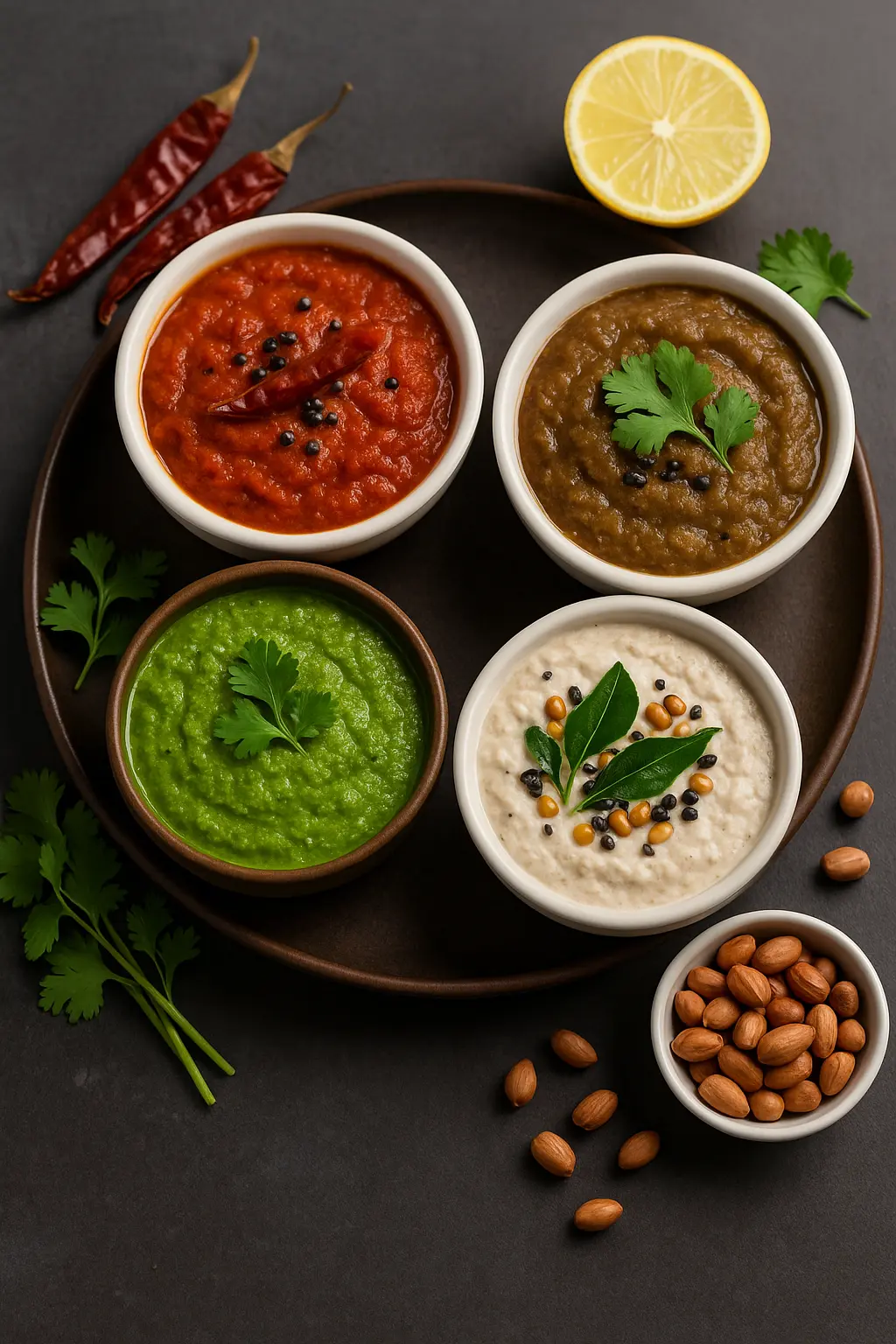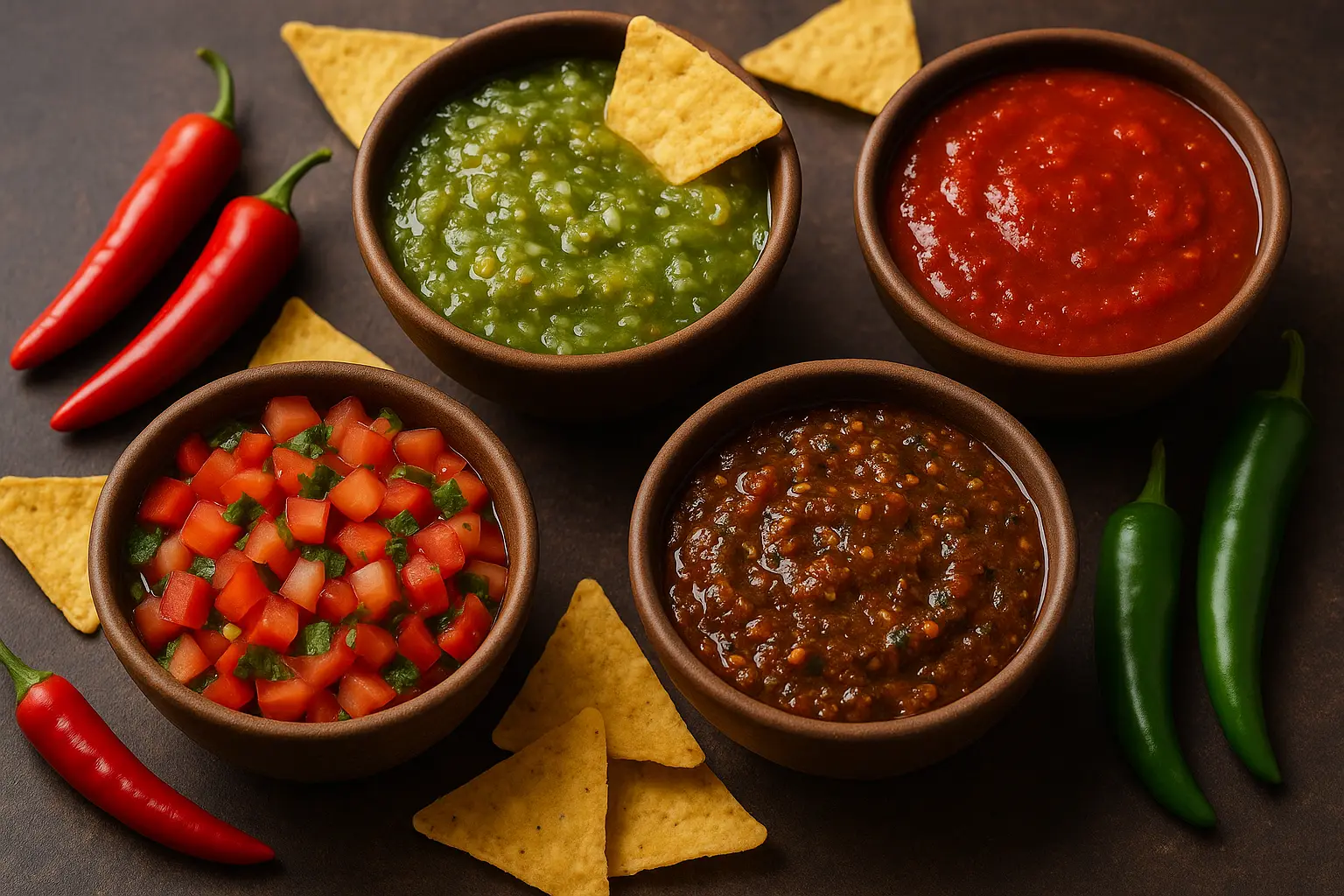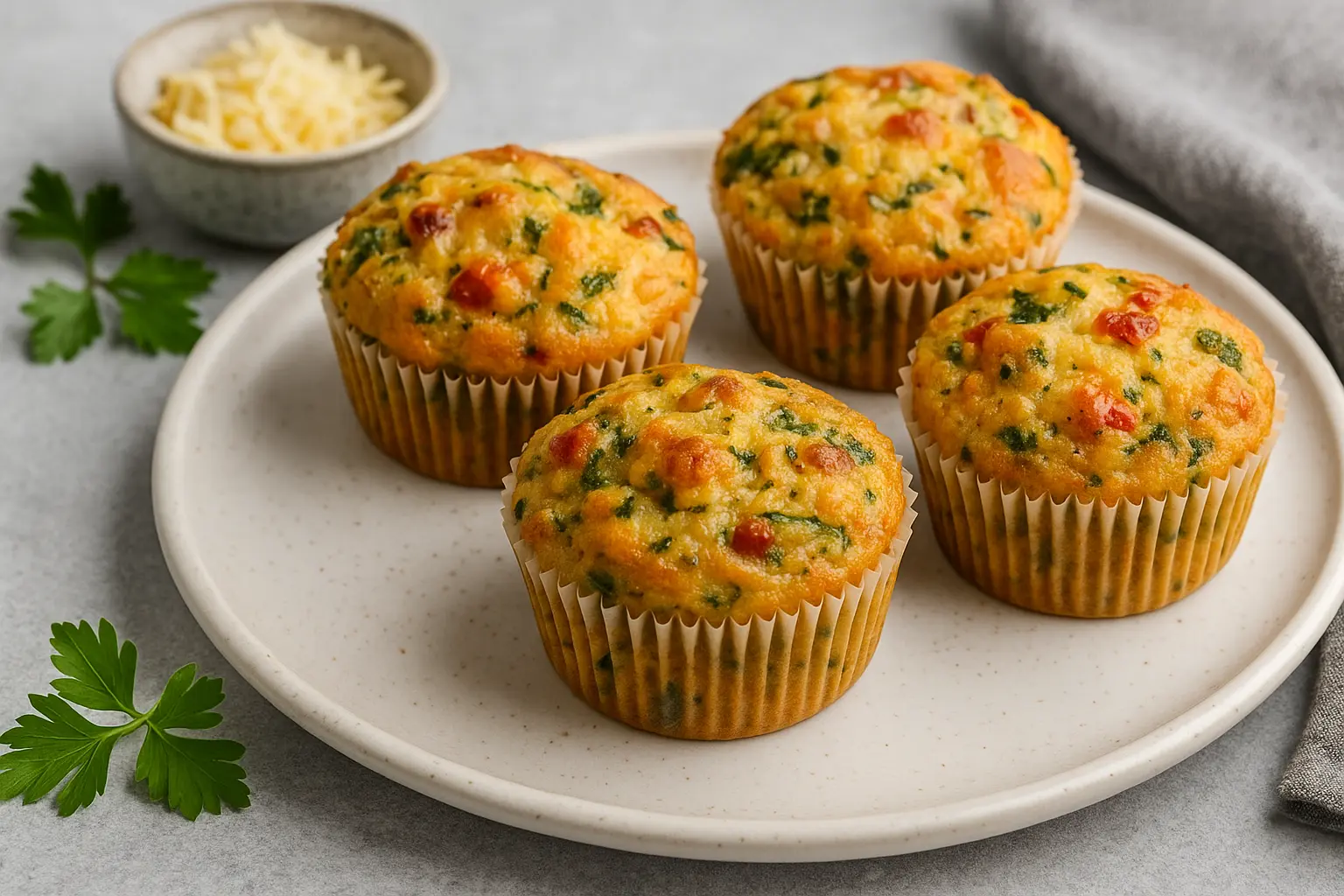Indian cuisine is incomplete without its vibrant chutneys and dips. While curries, breads, and rice form the main part of a meal, it’s the chutneys—those colorful, tangy, spicy, and sometimes sweet accompaniments—that truly elevate the experience. Across India’s diverse regions, chutneys and dips vary widely in flavor, ingredients, and traditions, yet they share one purpose: to enhance and complement food.
This guide takes a deep dive into the world of Indian chutneys and dips—covering history, traditional recipes, modern twists, regional varieties, and serving ideas. Whether you’re enjoying samosas, dosas, kebabs, or a simple dal-rice dinner, these condiments bring an extra burst of taste.

1. The Role of Chutneys in Indian Cuisine
Chutneys are more than just sidekicks—they are flavor enhancers that balance meals. In Indian cooking, where spice levels can vary and richness may dominate, chutneys cut through heaviness, refresh the palate, or intensify spice.
- Flavor Balance: Sweet chutneys mellow out heat, while spicy chutneys add zest to bland foods.
- Digestive Aid: Many chutneys use herbs, spices, or sour agents (like tamarind, lemon, or yogurt) that aid digestion.
- Cultural Significance: Chutneys appear in festive thalis, street food stalls, tiffin boxes, and family feasts.
From North India’s tangy tamarind chutney to South India’s coconut-based dips, chutneys adapt to local produce, climate, and cooking traditions.
2. Classic Indian Chutneys Everyone Should Know
Let’s explore the staples that feature in almost every Indian household:
2.1 Mint-Coriander Chutney (Hari Chutney)
- Flavor Profile: Fresh, herbaceous, slightly spicy, tangy.
- Key Ingredients: Mint leaves, coriander leaves, green chilies, lemon juice, roasted cumin, salt.
- Best With: Samosas, pakoras, sandwiches, kebabs, and chaats.
This chutney symbolizes freshness. A little spoonful can transform fried snacks or grilled tikkas into a feast. Adding yogurt makes it creamier and less sharp.
2.2 Tamarind Chutney (Imli Chutney)
- Flavor Profile: Sweet, tangy, slightly spicy.
- Key Ingredients: Tamarind pulp, jaggery (or sugar), cumin, dry ginger, chili powder.
- Best With: Chaats (like pani puri, bhel puri), samosas, kachoris.
Known as “meetha chutney,” this one balances heat from fried snacks with its syrupy tang. Every Indian street food vendor swears by it.
2.3 Coconut Chutney
- Flavor Profile: Creamy, mild, nutty.
- Key Ingredients: Fresh grated coconut, roasted chana dal, green chili, ginger, tempered with curry leaves and mustard seeds.
- Best With: Idlis, dosas, vadas, upma.
A South Indian staple, coconut chutney comes in many variations: with red chilies (red coconut chutney), roasted peanuts, or even yogurt.
2.4 Tomato Chutney
- Flavor Profile: Spicy, tangy, slightly smoky.
- Key Ingredients: Tomatoes, onions, garlic, dry red chilies, tempered with curry leaves.
- Best With: Dosas, parathas, rice, sandwiches.
This chutney is often pan-fried to enhance depth. In Andhra cuisine, it can be fiery, while Tamil versions tend to be balanced with sweetness.
2.5 Onion Chutney
- Flavor Profile: Spicy, pungent, with caramelized notes.
- Key Ingredients: Onions, red chilies, tamarind, garlic.
- Best With: South Indian breakfast dishes, parathas.
The onions bring a subtle sweetness that pairs beautifully with rice-based meals.
2.6 Peanut Chutney
- Flavor Profile: Nutty, slightly spicy, smooth.
- Key Ingredients: Roasted peanuts, garlic, chilies, tamarind.
- Best With: Dosas, upma, steamed rice.
An economical yet protein-rich option, especially in Andhra and Telangana homes.
2.7 Mango Chutney (Aam ki Chutney)
- Flavor Profile: Sweet, spicy, tangy.
- Key Ingredients: Raw mango or ripe mango, sugar, chili, mustard seeds.
- Best With: Rice, parathas, grilled meats, curries.
Raw mango chutneys (kacche aam ki chutney) are tangy and zesty, while ripe mango chutneys lean sweet. Both are summer favorites.
3. Regional Varieties of Chutneys in India
India’s diversity means every state, sometimes every community, has its own chutney specialties.
North India
- Bhindi (okra) chutney in Uttar Pradesh.
- Garlic chutney in Rajasthan, often dry and fiery.
- Pudina chutney as a summer staple across Delhi and Punjab.
South India
- Thogayal (Tamil Nadu): Thick chutney made with lentils, coconut, tamarind.
- Kara Chutney: Red chili-based, spicy dip.
- Curry Leaf Chutney: Strongly flavored with aromatic curry leaves.
East India
- Kasundi (Bengal): Mustard-based pungent dip, excellent with cutlets and fried snacks.
- Tomato-khejur chutney: Sweet chutney made with dates, often part of festive meals.
West India
- Dry garlic chutney in Maharashtra, served with vada pav.
- Lasun chutney in Gujarat, paired with theplas.
- Coconut-coriander chutneys in Goan cuisine with fish curries.
4. Modern & Fusion Indian Chutneys
While traditional chutneys hold their ground, modern kitchens experiment with:
- Avocado Mint Chutney: Blending global superfood with Indian flavors.
- Beetroot Chutney: Vibrant color, earthy taste, great with breads.
- Pumpkin Chutney: Seasonal twist, mildly spiced.
- Yogurt-Dill Chutney: Perfect with grilled meats or wraps.
Such innovations allow chutneys to move beyond Indian meals—pairing beautifully with chips, sandwiches, or even roasted veggies.
5. How to Serve and Store Indian Chutneys
Serving Ideas
- Pair mint chutney with kebabs or grilled paneer.
- Drizzle tamarind chutney over chaats.
- Spread tomato chutney in sandwiches.
- Mix coconut chutney into rice for quick meals.
Storage Tips
- Fresh chutneys (like mint) last 2–3 days in the fridge.
- Tamarind or mango chutneys can last weeks due to sugar content.
- Freezing chutneys in ice cube trays allows small, handy portions.
6. Nutritional & Health Benefits
Chutneys aren’t just flavorful—they carry health perks:
- Mint & coriander: Aid digestion, rich in antioxidants.
- Tamarind: Natural source of vitamin C and iron.
- Coconut: Provides healthy fats.
- Garlic chutney: Boosts immunity.
- Peanuts: Add plant-based protein.
Unlike calorie-heavy sauces or creams, chutneys often use fresh herbs and minimal oil, making them lighter accompaniments.
7. Recipes: Step-by-Step Chutney Preparations
Here are sample recipes you can include in your kitchen rotation:
Mint-Coriander Chutney
- Wash 1 cup coriander leaves, ½ cup mint leaves.
- Blend with 2 green chilies, 1 tsp roasted cumin, salt, and juice of 1 lemon.
- Add water for consistency. Store in airtight jar.
Tamarind Chutney
- Soak 1 cup tamarind pulp.
- Cook with ½ cup jaggery, 1 tsp chili powder, ½ tsp cumin powder, ½ tsp dry ginger.
- Simmer until thick. Cool and refrigerate.
Coconut Chutney
- Grind 1 cup fresh coconut, 2 tbsp roasted chana dal, 1 green chili, small piece ginger, salt.
- Add water to smooth.
- Temper with mustard seeds, curry leaves, and 1 red chili.
These quick recipes prove chutneys are simple yet transformative.
8. Chutneys in Everyday Life & Occasions
- Festivals: Mango chutney is prepared during summers, tomato-date chutney in Durga Puja feasts.
- Street Food: No pani puri, pav bhaji, or vada pav is complete without chutney.
- Home Cooking: A spoonful of chutney with plain dal-rice is a comfort-food tradition.
- Modern Dining: Restaurants now pair Indian chutneys with cheese platters or global fusion starters.
9. Tips for Perfect Chutneys
- Always use fresh herbs and spices for maximum flavor.
- Balance spice, tang, and sweetness—avoid overpowering one element.
- Roast nuts, spices, or chilies to deepen flavors.
- Don’t shy away from experimenting with seasonal fruits and veggies.
10. Conclusion
Indian chutneys and dips are the soul of Indian cuisine, turning simple meals into extraordinary experiences. They represent tradition, creativity, and a celebration of regional diversity. From classic coconut and tamarind to innovative beetroot and avocado variations, there’s a chutney for every taste and every meal.
So next time you cook, remember—sometimes it’s not the curry or the bread that makes the meal shine, but the humble chutney on the side.
Leave a comment
Your email address will not be published. Required fields are marked *




















